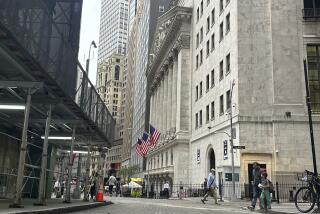Dow loses 265 points for the week
- Share via
The stock market closed out its worst week since August, but selling pressure was light and many on Wall Street think share prices could be readying for another advance.
Despite a modest gain Friday, the Dow Jones industrial average slid 265 points, or 1.7%, for the week. It’s down 2.1% from its late-November peak.
The market has been undermined by fear that the Federal Reserve could begin to rein in its economic-stimulus efforts at meetings next week. Most investors still expect the central bank to hold off on so-called tapering until early next year. But positive data lately, including solid retail sales and employment gains, have prompted speculation that Fed could act sooner.
The selloff comes on the heels of a powerful rally that has pushed the Dow up more than 20% this year. The broader Standard & Poor’s 500 index up 24.5%.
Share prices could sag further in the next couple of weeks, but few expect a sustained downturn.
“This is normal market volatility,” said Jay Wong, an equity fund manager at Los Angeles-based Payden & Rygel. “This is not anything significant or to be worried about. It’s not a signal of worry.”
The S&P 500 has gone 26 months without a correction of 10% or more, far exceeding the average 18-month span since 1945, according to research firm S&P Capital IQ.
“It’s been a huge run. Valuations are bit stretched,” said Russ Koesterich, global chief investment strategist at BlackRock Inc.
Besides concern about the Fed, investors are sorting out the potential effect of the federal budget deal emerging from Washington. And some professional investors are lightening their portfolios to lock in annual gains that must be reported to clients in year-end account statements.
Many of the fundamentals underpinning the stock rally remain bullish, said Paul Desmond, president of Lowry Research Corp. in Palm Beach Gardens, Fla.
For example, the number of stocks that rise in price each day continues to exceed the number falling in value. Decliners consistently exceeding advancers is a sign that a market top is nearing.
The bull market, which is nearing the end of its fifth year, is “a little gray around the temples” and the recent selling pressure might continue for another week or two.
But “there are quite a number of signs that say new highs for the broad market are still ahead of us,” Desmond said.
Tobias Levkovich, a strategist at Citi Research, is bullish long-term, but thinks stocks could fall further in the next few weeks.
“We’re not worried about a real substantive bad correction, but we have been talking about a 5-7% correction off of the peak,” he said.
History suggests that stocks won’t soar in 2014 but still could notch a solid year.
Since 1945, there have been 21 years in which the S&P 500 rose more than 20%, according to S&P Capital IQ. The index notched an average 10% gain the following year. That’s better than the market’s 8.7% average gain for all years since World War II.
On Friday, the Dow rose 15.93 points, or 0.1%, to 15,755.36. The S&P fell .01%.
Small-cap stocks have fallen during the recent selling. The Russell 2000 index is down 3.1% from its high, though it was up 0.3% Friday.
A drop in smaller stocks sometimes is a precursor of a drop in the broader market. But given that small caps had a bigger rally early in the year, the decline isn’t worrisome, experts said.
“If you’re going to take some chips off the table,” Wong said, “it would make some sense to lighten up on the most volatile, best-performing, highest-valuation stocks if you want to protect yourself against a potential sell-off.”
More to Read
Inside the business of entertainment
The Wide Shot brings you news, analysis and insights on everything from streaming wars to production — and what it all means for the future.
You may occasionally receive promotional content from the Los Angeles Times.










